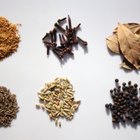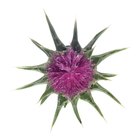Allantoin is a common ingredient in everyday cosmetic products, including shampoo, lipstick, moisturizers and lotions. Allantoin and lanolin are sometimes used in the same products; however, the two compounds are chemically unrelated and do not share a chemical classification.
Production of Allantoin
Allantoin is found in the leaves of the comfrey plant and in the urine of most mammals. However, commercial allantoin is usually produced synthetically by companies like Akema Fine Chemicals.
Production of Lanolin
While allantoin is produced artificially and found in hundreds of natural sources, lanolin can only be extracted from a single source: sheep's wool. It is produced as a by-product of the wool industry.
Texture Differences
While lanolin's texture is waxy, gummy and thick, allantoin feels slippery and moist against the skin. Lanolin may be used as a thickener in cosmetics, whereas allantoin imparts a smooth texture.
Considerations
Because lanolin is produced from the wool of sheep, people who follow strict vegan lifestyles may choose to avoid it. However, synthetic and plant-based forms of allantoin are considered to be vegan-friendly.
Misconceptions
In nature, allantoin can be found in the placental tissues of many mammals. This fact has spawned a fairly common misconception that allantoin is made from the fetal tissue or placenta.
Related Articles

Okara Nutrition

Skin Care Products That Contain ...

What Is Dye Made From?

Ingredients of Fingernail Polish Remover

Merle Norman Ingredients

What Are the Benefits of Extrapone ...

Palmolive Shampoo Ingredients

What Is Glycerine Used For?

Fiber Sure by Metamucil Ingredients

Side Effects of Monosodium Glutamate

Does Milk Thistle Lower Liver Enzymes?

What Are the Ingredients in Elizabeth ...

What Are the Dangers of Fraxel Repair?

Gluten- and Wheat-Free Fiber Supplements

The Benefits of Castile Soap

Ingredients of Gelatin

Difference Between Soap & Synthetic ...

Difference Between Canned Pumpkin & ...

What Is the Nutritional Value of Wheat?

Aloe Ferox Benefits
References
Writer Bio
Juniper Russo, an eclectic autodidact, has been writing professionally since 2008. Her work has appeared in several online and print-based publications, including Animal Wellness. Russo regularly publishes health-related content and advocates an evidence-based, naturopathic approach to health care.